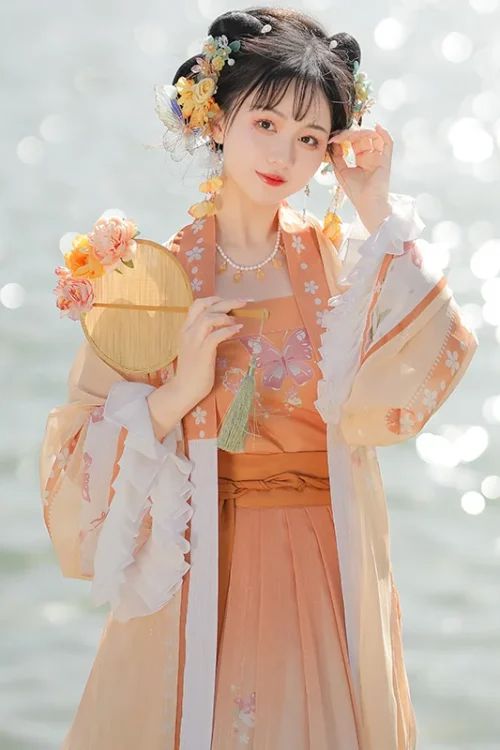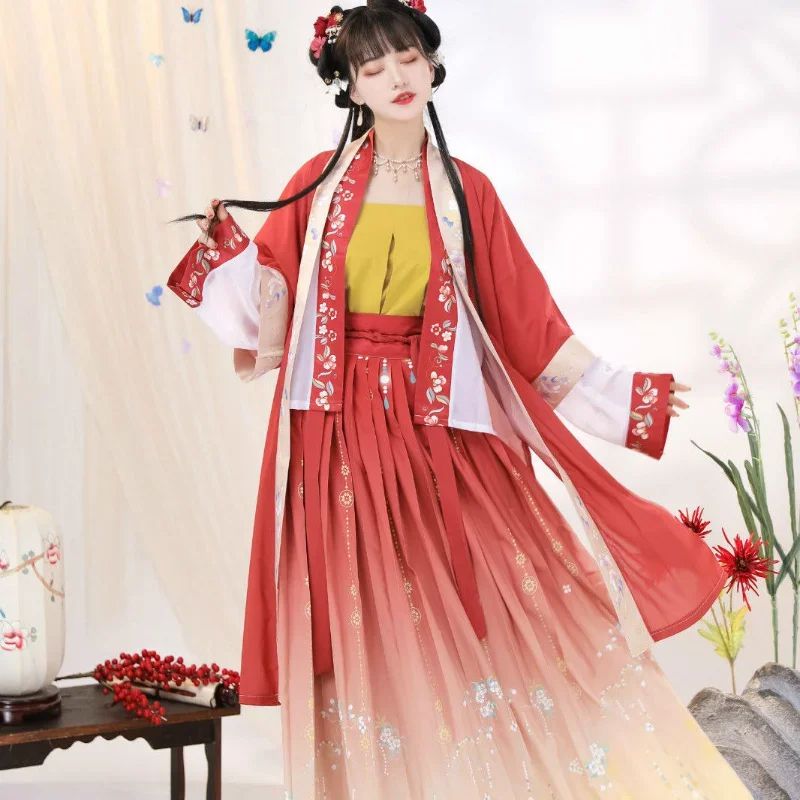汉服 in Classical Chinese Literature: Symbolism and Significance
During the Song Dynasty, Hanfu, the traditional clothing of the Han Chinese, played a pivotal role in literature and art, serving as a potent symbol of cultural identity and aesthetic refinement. In literary works, Hanfu was imbued with profound meanings, reflecting the wearer’s social status, moral character, and emotional state.

Symbolism in “Water Margin”
In the classic novel “Water Margin,” the heroes’ distinctive Hanfu symbolized their unwavering loyalty and rebellious spirit. The intricate embroidery and vibrant colors of their garments conveyed their individuality and their defiance against the corrupt ruling class. Similarly, in the epic poem “The Romance of the Three Kingdoms,” the Hanfu worn by the legendary generals represented their military prowess and strategic brilliance.
Inspiration for Artists
Beyond its symbolic significance, Hanfu also served as a source of inspiration for artists. Painters and calligraphers captured the flowing lines and elegant silhouettes of Hanfu in their works, creating masterpieces that celebrated the beauty and grace of the human form. The renowned Song Dynasty painter Zhang Zeduan’s iconic scroll “Along the River During the Qingming Festival” depicts a bustling city scene, where the vibrant colors and intricate patterns of Hanfu add a sense of vitality and festivity to the composition.
Flourishing Hanfu Culture
The Song Dynasty witnessed a flourishing of Hanfu culture, with new styles and designs emerging. The “ruqun,” a long, flowing skirt worn by women, became a symbol of feminine elegance and refinement. The “changpao,” a long robe worn by both men and women, represented scholarly pursuits and intellectual achievement. These garments were not merely articles of clothing but also expressions of the Song Dynasty’s cultural values and aesthetic sensibilities.
Regional Influence
The influence of Hanfu extended beyond the borders of China. In neighboring countries such as Japan and Korea, Hanfu was adopted and adapted, becoming an integral part of their own cultural traditions. The Japanese kimono and the Korean hanbok both bear striking similarities to Hanfu, reflecting the profound impact of Chinese culture on East Asian civilization.
结论
In conclusion, the Song Dynasty Hanfu played a multifaceted role in literature and art. It was a symbol of cultural identity, a source of inspiration for artists, and a testament to the enduring legacy of Chinese civilization. Through its intricate designs, vibrant colors, and profound meanings, Hanfu continues to captivate and inspire people to this day.
The Influence of Hanfu on Traditional Chinese Painting
During the Song Dynasty, Hanfu, the traditional Chinese attire, played a pivotal role in literature and art, particularly in painting. The intricate designs, flowing fabrics, and vibrant colors of Hanfu captivated the imaginations of artists, who used it as a means to express cultural identity, social status, and personal style.

Meticulous Depictions
In Song Dynasty paintings, Hanfu was often depicted with meticulous detail, reflecting the high level of craftsmanship and artistry of the period. The robes were rendered in a variety of materials, including silk, brocade, and gauze, each with its own unique texture and drape. Artists paid close attention to the patterns and motifs embroidered on the garments, which often carried symbolic meanings or represented the wearer’s social rank.
Social Hierarchy in Art
The depiction of Hanfu in paintings also served to convey social hierarchy and status. The elaborate and ornate robes worn by emperors, officials, and wealthy merchants contrasted sharply with the simpler garments of commoners. This visual distinction reinforced the rigid social structure of the Song Dynasty and provided viewers with a glimpse into the different strata of society.
Personal Style and Expression
Beyond its social significance, Hanfu also played a role in expressing personal style and individuality. The choice of colors, fabrics, and accessories allowed individuals to showcase their taste and preferences. Paintings often depicted women in elegant Hanfu, their robes adorned with delicate flowers, butterflies, or auspicious symbols. These depictions reflected the growing emphasis on personal expression and the pursuit of beauty during the Song Dynasty.
Artistic Innovation
The influence of Hanfu on Song Dynasty painting extended beyond its visual representation. The flowing lines and graceful movements of the garments inspired artists to create dynamic and expressive compositions. The interplay of colors and textures in Hanfu provided a rich palette for painters to explore, leading to the development of new and innovative painting techniques.
结论
In conclusion, Hanfu played a multifaceted role in Song Dynasty literature and art, particularly in painting. Its intricate designs, vibrant colors, and symbolic meanings captivated artists, who used it to express cultural identity, social status, personal style, and artistic innovation. The depiction of Hanfu in paintings not only provides a glimpse into the fashion and customs of the period but also reflects the broader cultural and artistic achievements of the Song Dynasty.
Hanfu as a Source of Inspiration in Modern Chinese Literature and Art
The Song Dynasty, renowned for its cultural and artistic achievements, left an enduring legacy on Chinese literature and art through the exquisite Hanfu garments of the era. Hanfu, the traditional clothing of the Han Chinese, played a pivotal role in shaping the aesthetic sensibilities and inspiring the creative minds of the time.

Characterization and Storytelling
In literature, Hanfu became an integral part of characterization and storytelling. The intricate designs, vibrant colors, and flowing fabrics of Hanfu conveyed the social status, personality, and emotions of characters. For instance, in the classic novel “Water Margin,” the hero Song Jiang is often depicted wearing a luxurious silk robe adorned with intricate embroidery, reflecting his high rank and noble spirit.
Poetic Inspiration
Hanfu also served as a source of inspiration for poets and writers. The graceful lines and elegant silhouettes of the garments evoked poetic imagery and lyrical descriptions. In the poem “Ode to the Hanfu,” the renowned poet Su Shi extols the beauty of Hanfu, comparing its flowing sleeves to the wings of a crane and its delicate embroidery to the petals of a flower.
Artistic Fascination
In the realm of art, Hanfu became a subject of fascination for painters and calligraphers. Artists such as Zhang Zeduan and Li Gonglin captured the vibrant street scenes of the Song Dynasty, where people from all walks of life adorned in colorful Hanfu filled the bustling markets and thoroughfares. The flowing robes and intricate headwear of the figures in these paintings added a sense of movement and dynamism to the compositions.
Interplay with Calligraphy
Calligraphers also found inspiration in the patterns and textures of Hanfu. The flowing lines of the garments resembled the brushstrokes of calligraphy, creating a harmonious interplay between the written word and the visual arts. In the famous painting “The Palace Museum,” by the artist Ma Yuan, the intricate embroidery on the Hanfu of the imperial concubines echoes the delicate brushwork of the calligraphy on the scrolls they hold.
Cultural Exchange
The influence of Song Dynasty Hanfu extended beyond the confines of China. In neighboring countries such as Japan and Korea, Hanfu became a symbol of cultural exchange and artistic inspiration. Japanese court attire, known as “kariginu,” was heavily influenced by the design and aesthetics of Hanfu, while Korean traditional clothing, known as “hanbok,” also incorporated elements of Hanfu.
Contemporary Resurgence
In modern times, Song Dynasty Hanfu has experienced a resurgence in popularity as a source of inspiration for contemporary Chinese literature and art. Writers and artists have drawn upon the rich cultural heritage of Hanfu to create works that celebrate Chinese identity and explore themes of tradition and modernity.
结论
From the vibrant pages of novels to the canvases of contemporary paintings, Song Dynasty Hanfu continues to captivate and inspire, serving as a testament to the enduring power of Chinese culture and the timeless beauty of its traditional garments.
